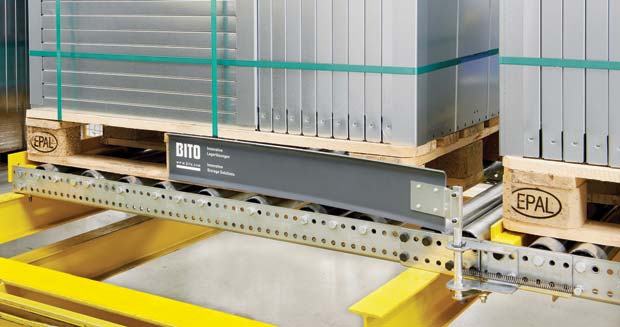BITO has completely revised its pallet live-storage system and will be introducing it to the market at the start of 2013. Called PROflow, the new pallet live system can be matched to individual user requirements using the modular building block principle. It is also very easy to expand or modify retrospectively. PROflow’s innovative feature is the new M-Stop load separator. The load separator has been designed to be completely out of reach of a lift truck forks and is therefore not susceptible to damage. This increases functional safety while simplifying handling in the store.

PROflow is based on BITO’s renowned PRO pallet racking system, which the company launched in 2008. PROflow includes BITO’s sliding and live racking systems, which have a number of advantages compared with standard pallet racking. These include increased storage of up to 60 per cent; high-volume utilisation based on the FIFO (First In First Out) principle, which assists on shelf-life monitoring; separation of replenishment and picking aisles, which helps improve safety avoid reciprocal faults and increase productivity; and, by allowing more product to be stored at the pick location, a reduction of internal transport.
The main constituents of the live racking are the dynamic components, which include the support rollers, braking rollers and load separator. Load separators ensure that the second pallet in the live racking system is kept at a distance from the first, enabling the first pallet to be removed without interference.
There are various stages of evolution in the field of load separators available on the market. On the one hand, there is the load separator with rigid coupling. When the control flag is depressed by the pallet, the pallet stop locks and the second pallet in the channel is held back. In the event of functional faults or operator error, the rigid coupling often leads to damage and therefore to safety risks. On the other hand, there is the decoupled load separator, where the control flag is always connected to the pallet stop by means of a linkage but the connection is decoupled in the event of functional faults and operator errors. This causes less damage to the separator.
BITO is now launching the next generation of load separator – The M-Stop, which dispenses entirely with a control flag and a linkage. The separator is outside the range of the stacker and is therefore protected against damage.
BITO’s new load separator meets a further challenge. With conventional solutions using control flags, pallets will often not move right up to the end stop. The stacker driver, who for safety reasons should not get too close to the racking, therefore often does not have the pallet fully on the forks when he lifts it. Depending on how heavily the pallet is loaded, there is a risk of the stacker truck toppling. If the pallet is not fully on the forks, the stacker must re-engage with it. To do this, he sets the pallet down. This can trigger the load separator and the next pallet comes along making it considerably more difficult for the stacker driver to remove the first pallet. As a control flag is no longer necessary with the M-Stop, the roller conveyor can be continuously occupied. BITO brake rollers stop the pallet in a controlled manner. The pallet is therefore always in the right position and the stacker driver can lift it completely without having to re-engage or drive too close to the racking. This means considerable time saving and increased safety.
The M in the name M-Stop stands on the one hand for multifunctional – one load separator can be used for all platform solutions – and on the other for modular, as the new, compact load separator is made up of standardised components. If a component is damaged, it can be replaced in a very short time. As a result, there are no repair costs or down-time due to damaged separators. The new M-Stop therefore has high availability and is functionally safe.
A further feature of the PROflow modular system is its high storage capacity. The support rollers, on which the pallets roll from the loading to the removal side with the help of gravity, are mounted in inwardly facing L-sections. Outward-facing U-sections are commonly found in the market. As, with the L-sections, the leg faces inwards, BITO requires less space for its roller conveyor segments and can make the design more compact. The result is a five per cent greater storage capacity.
In addition to the product features, BITO’s new PROflow also enables the user to tailor the system to their own special requirements – for a particular pallet type or for particular loads, for example – and provides different options such as conveyor sections, which fold upwards to enable the floor to be cleaned or a lift truck to be used for removing the pallets. If modifications are made to the store, the user can extend, convert, lengthen or shorten their system as required thanks to its modularity. This cannot be done so easily, quickly or cost effectively with individual solutions.
This benefit comes from BITO’s platform strategy: a common basis for the different variants and the use of standardised components. These also ensure smooth operation for the user, as components can be quickly replaced if required. The modular principle enables BITO to produce the individual elements as standard without the need to manufacture them to a particular order. The warehousing specialist is therefore able to offer complete solutions within only a few weeks.
BITO Storage Systems




Comments are closed.